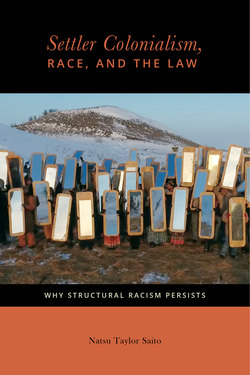Читать книгу Settler Colonialism, Race, and the Law - Natsu Taylor Saito - Страница 43
На сайте Литреса книга снята с продажи.
“Recognition”
ОглавлениеOne of the hallmarks of settler colonial dominion is the imposition of identity on those over whom the state claims jurisdiction. Repeatedly, we see racialized identities thrust upon peoples in ways that are arbitrary and inconsistent, yet clearly intended to serve particular purposes. With respect to American Indians, a primary goal of such identity construction has always been the numerical reduction of the population. Using the pseudoscientific notion of “blood quantum,” the settler state has counted Indigenous people “out of existence,” at least from the colonial perspective, by requiring them to prove a particular “degree of Indian blood”—usually one-quarter or one-half—to be recognized as Indians, a practice Veracini terms “transfer by accounting.”102 This system has predictably shrunk the federally recognized American Indian population as well as its land base.103
In the 1880s, the US government employed such definitions to limit the number of Indians eligible for individual allotments of land and to open up the resulting “surplus” lands—territories that had been held collectively by Indian nations—to White settlement.104 Between 1885 and 1934 this process resulted in the loss of two-thirds of the land still in Indigenous possession.105 Since then federal and state governments have extended their power to define peoples by selectively according “recognition” to American Indian “tribes,” a process that has been used to dictate how they will be organized, to allocate or withdraw funding based on their willingness to comply with settler state policy, and to un-recognize or “terminate” them at will.106 By “allowing” tribal authorities some discretion with respect to membership while allocating “benefits” in lump-sum fashion, the settler state has incentivized tribal governments to pare down their membership rolls to maximize benefits for remaining members, thereby internalizing the process of counting themselves into extinction.107
Beyond numerical reduction, the settler state’s usurpation of the right of Indigenous peoples to define themselves constitutes an attempt to erase indigeneity by racialization. Innumerable distinct polities, cultures, and relational networks are collapsed into a vacuous identity based on arbitrarily assigned phenotypical and cultural characteristics.108 The result is the transformation of hundreds of nations into a single “race,” which is then categorized as a “minority group” within the settler body politic. This strategy, as Veracini points out, lays the groundwork for “resolving” the underlying problem of illegitimate occupation through a process of “reconciliation” intended to result in “relegitimation and settler self-supersession.”109 It also has serious legal implications for Indigenous rights, since “minorities” are generally guaranteed only equal treatment under international law, whereas “peoples” have a right to self-determination.
